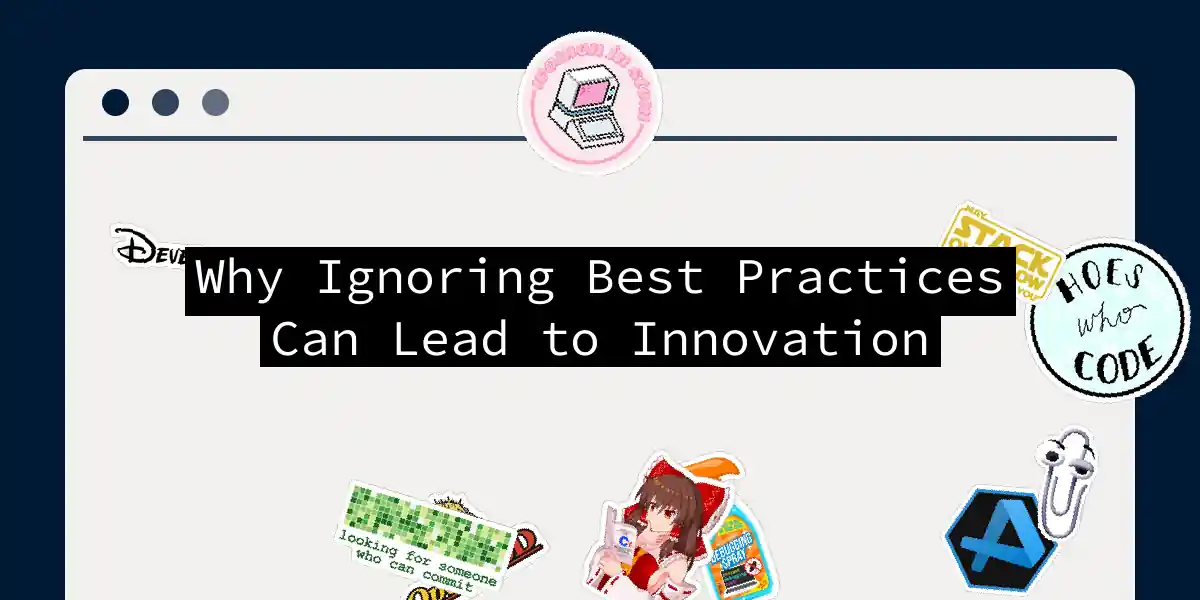Picture this: You’re baking cookies using your grandma’s century-old recipe. Suddenly, you swap raisins for chili flakes. Either you’ve invented the next viral snack or you’ll need fire extinguishers on standby. That’s innovation in a nutshell – sometimes, ignoring the “best practices” leads to glorious breakthroughs or spectacular dumpster fires. Today, we’re exploring why skipping established rules might be your ticket to real innovation.
The Seductive Trap of Best Practices
Best practices are like comfort food for businesses – familiar, reliable, and dangerously habit-forming. They’re the “industry-standard” playbooks that promise safety but often lock us in mental cages. Consider these innovation roadblocks:
- The Competency Trap
Companies over-rely on what worked before, like Nokia clinging to physical keyboards while smartphones ate their lunch. It’s like using a typewriter in a voice-recognition world – nostalgic but doomed. - The Copycat Curse
Blindly adopting another company’s “proven” rules is like wearing someone else’s prescription glasses. McKinsey notes that Pixar’s creative rules won’t fit Under Armour any better than ballet slippers fit an NFL linebacker. - The Shelf-Life Illusion
Best practices have expiration dates. Banking’s “best practices” pre-2008 financial crash? Later exposed as catastrophic groupthink. Viima compares them to milk cartons – ignore the “best before” date at your peril.
When Breaking Rules Sparks Magic
Now, let’s flip the script. Here’s how ignoring best practices fuels innovation, with battle-tested tactics:
1. Rewrite Research Rules (Intelligently)
Traditional best practice says “research exhaustively before building.” But over-researching murders momentum. Instead:
- Build a “minimum terrible prototype” in 48 hours (yes, terrible)
- Test it with 5 real users
- Iterate based on their most visceral reactions
Example: We once bypassed 6 months of market research for a SaaS tool by creating a deliberately ugly Figma mockup. User feedback like “this looks like my toaster’s UI” revealed more than any survey.
2. The Problem-Detour Technique
Best practices demand solving “validated problems.” Break this by:
- Identifying an assumed pain point (e.g., “slow checkouts”)
- Deliberately solving the opposite (“too few product details”)
- Measuring unexpected engagement spikes
One team created absurdly detailed product stories for an e-commerce app – conversion jumped 27% because users felt informed, not rushed.
3. The Anti-Linear Innovation Sprint
Forget the “ideate → build → launch” linearity. Try this chaotic loop:
while not breakthrough:
build_ugly_prototype()
user_feedback = test_with_3_humans()
if user_feedback.eyes_glaze_over: pivot()
if user_feedback.screams: iterate()
Time-box each loop to 72 hours. The goal isn’t perfection – it’s triggering unexpected user reactions.
Your Rule-Breaking Toolkit
Apply these in your next project:
- The “Why the Hell Not” Test
When deciding whether to follow a best practice, ask:
“If we deliberately did the opposite for 2 weeks, what would explode?”
If the answer is “probably nothing catastrophic,” experiment. - Best Practice Obituary Writing
Literally draft a mock press release:
“We regret to announce the death of [Best Practice]. It served us well until [Date], but perished from acute irrelevance.”
Macabre? Maybe. Effective? Absolutely. - The Innovation “Shots Fired” Board
Create a public dashboard listing:- 1 “best practice” being violated this sprint
- The expected disaster vs. actual outcome
- Team member who fired the shot
Reward spectacular failures with cheap trophies.
Case Study: Zumba vs. The Fitness Rules
Fitness industry best practices circa 2000:
- Structured 8-count choreography
- Certified instructors only
- Repetitive music
Zumba said “nah.” Founder Beto Perez used: - Unrehearsed dance moves
- Instructors from nightclub backgrounds
- Playful, unpredictable routines
Result? A global fitness revolution by breaking every “best practice”.
Conclusion: Your Move, Rulebreaker
Best practices are training wheels – useful until they slow you down. True innovation happens when you treat them like suggestions, not scripture. So next time someone says “but the industry standard is…,” channel your inner rebel baker. Toss in those chili flakes. Worst case? You order pizza. Best case? You invent the next big thing.
“Innovation is stumbling into a dark room, accidentally flipping the light switch, and realizing you’ve been in the kitchen all along.” – Me, 5 minutes ago
